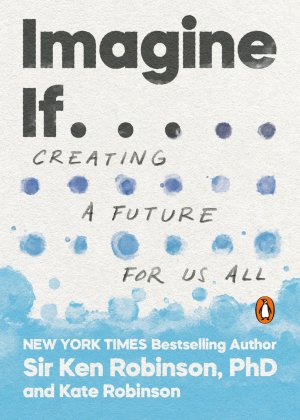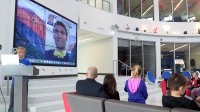What Is Education For?
Read an excerpt from a new book by Sir Ken Robinson and Kate Robinson, which calls for redesigning education for the future.
Your content has been saved!
Go to My Saved Content.What is education for? As it happens, people differ sharply on this question. It is what is known as an “essentially contested concept.” Like “democracy” and “justice,” “education” means different things to different people. Various factors can contribute to a person’s understanding of the purpose of education, including their background and circumstances. It is also inflected by how they view related issues such as ethnicity, gender, and social class. Still, not having an agreed-upon definition of education doesn’t mean we can’t discuss it or do anything about it.
We just need to be clear on terms. There are a few terms that are often confused or used interchangeably—“learning,” “education,” “training,” and “school”—but there are important differences between them. Learning is the process of acquiring new skills and understanding. Education is an organized system of learning. Training is a type of education that is focused on learning specific skills. A school is a community of learners: a group that comes together to learn with and from each other. It is vital that we differentiate these terms: children love to learn, they do it naturally; many have a hard time with education, and some have big problems with school.

There are many assumptions of compulsory education. One is that young people need to know, understand, and be able to do certain things that they most likely would not if they were left to their own devices. What these things are and how best to ensure students learn them are complicated and often controversial issues. Another assumption is that compulsory education is a preparation for what will come afterward, like getting a good job or going on to higher education.
So, what does it mean to be educated now? Well, I believe that education should expand our consciousness, capabilities, sensitivities, and cultural understanding. It should enlarge our worldview. As we all live in two worlds—the world within you that exists only because you do, and the world around you—the core purpose of education is to enable students to understand both worlds. In today’s climate, there is also a new and urgent challenge: to provide forms of education that engage young people with the global-economic issues of environmental well-being.
This core purpose of education can be broken down into four basic purposes.
Personal
Education should enable young people to engage with the world within them as well as the world around them. In Western cultures, there is a firm distinction between the two worlds, between thinking and feeling, objectivity and subjectivity. This distinction is misguided. There is a deep correlation between our experience of the world around us and how we feel. As we explored in the previous chapters, all individuals have unique strengths and weaknesses, outlooks and personalities. Students do not come in standard physical shapes, nor do their abilities and personalities. They all have their own aptitudes and dispositions and different ways of understanding things. Education is therefore deeply personal. It is about cultivating the minds and hearts of living people. Engaging them as individuals is at the heart of raising achievement.
The Universal Declaration of Human Rights emphasizes that “All human beings are born free and equal in dignity and rights,” and that “Education shall be directed to the full development of the human personality and to the strengthening of respect for human rights and fundamental freedoms.” Many of the deepest problems in current systems of education result from losing sight of this basic principle.
Cultural
Schools should enable students to understand their own cultures and to respect the diversity of others. There are various definitions of culture, but in this context the most appropriate is “the values and forms of behavior that characterize different social groups.” To put it more bluntly, it is “the way we do things around here.” Education is one of the ways that communities pass on their values from one generation to the next. For some, education is a way of preserving a culture against outside influences. For others, it is a way of promoting cultural tolerance. As the world becomes more crowded and connected, it is becoming more complex culturally. Living respectfully with diversity is not just an ethical choice, it is a practical imperative.
There should be three cultural priorities for schools: to help students understand their own cultures, to understand other cultures, and to promote a sense of cultural tolerance and coexistence. The lives of all communities can be hugely enriched by celebrating their own cultures and the practices and traditions of other cultures.
Economic
Education should enable students to become economically responsible and independent. This is one of the reasons governments take such a keen interest in education: they know that an educated workforce is essential to creating economic prosperity. Leaders of the Industrial Revolution knew that education was critical to creating the types of workforce they required, too. But the world of work has changed so profoundly since then, and continues to do so at an ever-quickening pace. We know that many of the jobs of previous decades are disappearing and being rapidly replaced by contemporary counterparts. It is almost impossible to predict the direction of advancing technologies, and where they will take us.
How can schools prepare students to navigate this ever-changing economic landscape? They must connect students with their unique talents and interests, dissolve the division between academic and vocational programs, and foster practical partnerships between schools and the world of work, so that young people can experience working environments as part of their education, not simply when it is time for them to enter the labor market.
Social
Education should enable young people to become active and compassionate citizens. We live in densely woven social systems. The benefits we derive from them depend on our working together to sustain them. The empowerment of individuals has to be balanced by practicing the values and responsibilities of collective life, and of democracy in particular. Our freedoms in democratic societies are not automatic. They come from centuries of struggle against tyranny and autocracy and those who foment sectarianism, hatred, and fear. Those struggles are far from over. As John Dewey observed, “Democracy has to be born anew every generation, and education is its midwife.”
For a democratic society to function, it depends upon the majority of its people to be active within the democratic process. In many democracies, this is increasingly not the case. Schools should engage students in becoming active, and proactive, democratic participants. An academic civics course will scratch the surface, but to nurture a deeply rooted respect for democracy, it is essential to give young people real-life democratic experiences long before they come of age to vote.
Eight Core Competencies
The conventional curriculum is based on a collection of separate subjects. These are prioritized according to beliefs around the limited understanding of intelligence we discussed in the previous chapter, as well as what is deemed to be important later in life. The idea of “subjects” suggests that each subject, whether mathematics, science, art, or language, stands completely separate from all the other subjects. This is problematic. Mathematics, for example, is not defined only by propositional knowledge; it is a combination of types of knowledge, including concepts, processes, and methods as well as propositional knowledge. This is also true of science, art, and languages, and of all other subjects. It is therefore much more useful to focus on the concept of disciplines rather than subjects.
Disciplines are fluid; they constantly merge and collaborate. In focusing on disciplines rather than subjects we can also explore the concept of interdisciplinary learning. This is a much more holistic approach that mirrors real life more closely—it is rare that activities outside of school are as clearly segregated as conventional curriculums suggest. A journalist writing an article, for example, must be able to call upon skills of conversation, deductive reasoning, literacy, and social sciences. A surgeon must understand the academic concept of the patient’s condition, as well as the practical application of the appropriate procedure. At least, we would certainly hope this is the case should we find ourselves being wheeled into surgery.
The concept of disciplines brings us to a better starting point when planning the curriculum, which is to ask what students should know and be able to do as a result of their education. The four purposes above suggest eight core competencies that, if properly integrated into education, will equip students who leave school to engage in the economic, cultural, social, and personal challenges they will inevitably face in their lives. These competencies are curiosity, creativity, criticism, communication, collaboration, compassion, composure, and citizenship. Rather than be triggered by age, they should be interwoven from the beginning of a student’s educational journey and nurtured throughout.
From Imagine If: Creating a Future for Us All by Sir Ken Robinson, Ph.D and Kate Robinson, published by Penguin Books, an imprint of Penguin Publishing Group, a division of Penguin Random House, LLC. Copyright © 2022 by the Estate of Sir Kenneth Robinson and Kate Robinson.
